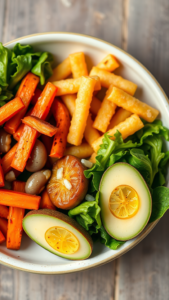Determining the Ideal Grams of Fat on a Keto Diet
Understanding the right amount of fat to consume on a ketogenic diet is crucial for achieving your health and fitness goals. The keto diet emphasizes high fat intake, moderate protein, and very low carbohydrates. Knowing how many grams of fat you should aim for can help ensure that you maintain ketosis, the metabolic state where your body burns fat for fuel instead of carbohydrates.
The typical keto diet macronutrient ratio recommends around 70-80% of daily calories coming from fats. This means if you are consuming 2,000 calories per day, you should have roughly 1400 to 1600 calories from fat. Since each gram of fat contains 9 calories, this translates to about 155 to 178 grams of fat daily.
Calculating Your Ideal Fat Intake
To determine the ideal grams of fat for your specific needs, consider the following steps:
- 1. Calculate Your Daily Caloric Needs: Use an online calculator or consult a nutritionist to find out how many calories you should consume each day based on your age, gender, weight, height, and activity level.
- 2. Set Your Macronutrient Ratio: Depending on your personal goals, choose a macronutrient ratio that fits your lifestyle. The common ratio for keto is approximately 75% fat, 20% protein, and 5% carbohydrates.
- 3. Determine Fat Calories: Multiply your total daily calories by your desired fat percentage. For example, if your daily intake is 2,000 calories, calculate 0.75 x 2000 = 1500 calories from fat.
- 4. Convert Calories to Grams: Since each gram of fat contains 9 calories, divide your fat calorie count by 9. For instance, 1500 ÷ 9 ≈ 167 grams of fat.
Sample Daily Macros for Different Caloric Intakes
Here’s a breakdown showing how varying daily calorie intakes affect your fat intake:
| Daily Calories | Fat % | Calories from Fat | Grams of Fat |
|---|---|---|---|
| 1500 | 75% | 1125 | 125 |
| 2000 | 75% | 1500 | 167 |
| 2500 | 75% | 1875 | 208 |
Choosing Healthy Fats
When you start this high-fat diet, the type of fat you choose is just as important as the amount. Focus on healthy fats to optimize your health:
- Avocados: Packed with fiber and heart-healthy monounsaturated fats.
- Olive Oil: Rich in antioxidants and anti-inflammatory compounds.
- Coconut Oil: Contains medium-chain triglycerides (MCTs) that provide a quick energy source.
- Nuts and Seeds: Offer healthy fats and essential nutrients.
- Fatty Fish: Great source of omega-3 fatty acids for heart health.
Monitoring Your Progress
As you adopt the keto lifestyle, regularly track your food intake and adjust your fat consumption as needed. Pay attention to how your body responds—energy levels, weight changes, and overall well-being are important indicators. Use tools like food diaries or smartphone apps to help you stay on track with your macros.
Ultimately, finding the right amount of fat on the keto diet is a personalized journey. Each person’s body is unique, and adjusting your intake may be necessary over time. If you ever feel unsure, consulting with a healthcare provider or a nutritionist can guide you toward reaching your goals more effectively.
By actively managing your fat intake and focusing on quality sources, you can maximize the benefits of the ketogenic diet while enjoying delicious food.
Understanding Macronutrient Ratios for Ketosis
When diving into the world of the ketogenic diet, understanding macronutrient ratios is crucial for achieving and maintaining ketosis. Ketosis is a metabolic state where your body burns fat for fuel instead of carbohydrates. To reach this state, you need to balance your intake of fats, proteins, and carbohydrates wisely.
The typical macronutrient ratio for a ketogenic diet is high in fat, moderate in protein, and very low in carbohydrates. This means that successfully following a keto diet allows you to indulge in delicious, calorie-dense fats while significantly restricting your carb intake.
Typical Macronutrient Ratios
While individual needs can vary depending on activity levels and health goals, a common starting point is:
- Fats: 70-75% of total daily caloric intake
- Proteins: 20-25% of total daily caloric intake
- Carbohydrates: 5-10% of total daily caloric intake
Here’s a breakdown of how to calculate these ratios:
Calculating Your Macronutrients
To tailor your keto diet to your needs, you can follow these steps:
- Determine your daily caloric intake. For example, if you consume 2000 calories a day, these will be the basis of your calculations.
- Calculate the percentage of macronutrients based on the typical ratios. Refer to the typical macronutrient ratios above to break it down:
| Macronutrient | Percentage | Calories | Grams |
|---|---|---|---|
| Fats | 75% | 1500 | 166.67 (1g = 9 calories) |
| Proteins | 20% | 400 | 100 (1g = 4 calories) |
| Carbohydrates | 5% | 100 | 25 (1g = 4 calories) |
According to this example, a 2000-calorie diet would contain approximately 166.67 grams of fat, 100 grams of protein, and 25 grams of carbohydrates. Adjust these numbers based on your specific dietary needs.
Why Fats Are Important
Dietary fat is the cornerstone of the keto diet. It provides energy and helps your body enter ketosis. Healthy fats to include in your diet are:
- Avocado oil
- Coconut oil
- Olive oil
- Nuts and seeds
- Fatty fish
It’s important to focus on high-quality fats to obtain essential fatty acids your body needs to function optimally.
Protein Intake
While a moderate protein intake is crucial for maintaining muscle mass, too much protein can be converted into glucose, which could knock you out of ketosis. It’s best to keep protein intake balanced—lean meats, eggs, and dairy products are excellent sources.
Carbohydrate Limitation
Your carb intake should be minimal to keep your body in a ketogenic state. Focus on low-carb vegetables like leafy greens, broccoli, and cauliflower. Avoid sugary foods, grains, and starchy vegetables, which can spike your blood sugar levels and disrupt ketosis.
Monitoring Your Progress
To ensure you’re maintaining the right macronutrient ratios, consider tracking your food intake. There are various apps available that can help you monitor your daily caloric and macronutrient consumption.
Successfully adopting a keto lifestyle revolves around understanding and implementing the right macronutrient ratios. By adjusting your intake of fats, proteins, and carbohydrates, you can effectively support your journey to achieve and sustain ketosis.
If you have specific health conditions or dietary needs, it may be beneficial to consult with a healthcare provider to tailor these macronutrient ratios to your personal goals.
Common Fat Sources for Keto Success
When following a ketogenic diet, understanding which fats to include can significantly impact your success. The key is to choose high-quality fat sources that will keep you satisfied and support your body’s energy needs while promoting ketosis. Here’s a guide to common fat sources that can help you thrive on a keto journey.
Natural Oils
Oils are essential for cooking and flavoring your meals. Here are some excellent options:
- Olive Oil: Packed with monounsaturated fats, it helps reduce inflammation and is great for salad dressings.
- Coconut Oil: High in medium-chain triglycerides (MCTs), coconut oil is a fantastic energy source and can aid in fat burning.
- Avocado Oil: Another source of healthy monounsaturated fats, avocado oil is versatile and has a high smoke point.
- Macadamia Nut Oil: This oil is rich in omega-7 fats, making it perfect for cooking and drizzling over dishes.
High-Fat Dairy Products
Dairy can be a delicious and satisfying source of fats on a keto diet. Choose full-fat options to maximize your fat intake:
- Heavy Cream: Use this to make sauces, coffee, or desserts for a rich, creamy flavor.
- Cheeses: Cheddar, mozzarella, and cream cheese are great choices, packed with flavor and healthy fats.
- Greek Yogurt: Opt for full-fat versions to keep your carb intake low while enjoying a creamy snack.
Nuts and Seeds
Nuts and seeds provide crunchy textures, flavors, and healthy fats. Use them wisely to add variety to your meals:
- Almonds: They’re high in vitamin E and perfect for snacking or adding to salads.
- Pecans: Rich in antioxidants, pecans are satisfying and low in carbs.
- Chia Seeds: These are packed with fiber and omega-3 fatty acids, making them a great addition to smoothies or puddings.
- Flaxseeds: Ground flaxseeds can add crunch and are excellent for baking or sprinkling on yogurt.
Animal Fats
Animal fats can provide a rich source of energy on a keto diet. Here’s what to consider:
- Grass-Fed Butter: Rich in vitamins, it’s great for cooking or spreading on veggies.
- Lard: This pig fat is a traditional cooking fat rich in omega-3s and can enhance flavor.
- Tallow: Beef fat works well for frying and roasting thanks to its high smoke point.
Fatty Fish
Your keto diet can greatly benefit from incorporating fatty fish, rich in omega-3 fatty acids. Some choices include:
- Salmon: A fantastic source of protein and healthy fats, it’s versatile for grilling or searing.
- Mackerel: This oily fish is delicious and can be enjoyed in salads or as a main dish.
- Sardines: Packed with nutrients, these can be eaten canned, smoked, or fresh.
Avocados
Avocados are often considered a superfood on the keto diet. They are rich in healthy monounsaturated fats and fiber, making them an excellent choice:
- Nutrition Profile: One medium avocado contains about 23 grams of fat and only 12 grams of carbohydrates, making it a keto-friendly food.
- Versatility: You can enjoy them in salads, smoothies, or simply mashed with spices.
Sample Fat Intake Table
| Food | Fat Content (per 100g) | Carbs (per 100g) |
|---|---|---|
| Coconut Oil | 100g | 0g |
| Avocado | 15g | 2g |
| Butter | 81g | 0g |
| Salmon | 13g | 0g |
By including these diverse fat sources in your diet, you’ll not only reap the health benefits but also enjoy satisfying and delicious meals. Remember to keep track of your macronutrient ratios to stay on target with your keto lifestyle.
The Role of Fat in Energy Production on a Keto Diet
The ketogenic diet is popular for many reasons, from weight loss to improved mental clarity. A core element of this diet is the significant role that fat plays in energy production. When you switch to a keto diet, your body undergoes a metabolic change. Instead of relying on carbohydrates for energy, it starts to burn fat. This shift can have profound effects on your overall health and energy levels.
On a standard diet, carbohydrates are typically the primary source of energy. However, when you significantly reduce your carb intake and increase your fat consumption, your body enters a state known as ketosis. In this state, your liver converts fatty acids into ketones, which your cells use for energy. Understanding how many grams of fat to consume is crucial for maintaining ketosis and optimizing energy production on a keto diet.
Understanding Daily Fat Intake
Determining how many grams of fat you need on a keto diet depends on several factors, including your personal health goals, activity level, and overall caloric intake. Generally, fat should make up about 70-80% of your total daily calories. Let’s break it down further.
Calculating Your Fat Needs
Follow these steps to find out how many grams of fat you should be consuming on a keto diet:
- Determine Your Daily Caloric Needs: Figure out your Total Daily Energy Expenditure (TDEE) using an online calculator based on your age, gender, weight, height, and activity level.
- Calculate Fat Calories: Multiply your TDEE by 0.70 to 0.80 to find out how many calories should come from fats.
- Convert to Grams: Since fat contains 9 calories per gram, divide the calorie amount from fats by 9 to find out how many grams you should consume.
For example, if your TDEE is 2,000 calories, you would aim for:
- 70% of 2,000 = 1,400 calories from fat
- 1,400 ÷ 9 = ~155 grams of fat
Quality of Fats Matters
Not all fats are created equal. If you’re following a keto diet, focus on healthy fats that provide numerous health benefits. Here are some good sources of healthy fats:
- Avocados: Rich in monounsaturated fats and nutrients.
- Nuts and Seeds: Providing omega-3 fatty acids and protein.
- Olive Oil: Contains healthy fats that support heart health.
- Coconut Oil: Offers medium-chain triglycerides (MCTs) which may promote faster ketone production.
- Grass-Fed Butter: A good source of conjugated linoleic acid (CLA).
The Benefits of Fat for Energy Production
Shifting to a higher fat intake can benefit your energy levels in various ways:
- Consistent Energy Levels: Unlike quick bursts of energy from carbs, fat provides a stable source of energy that lasts longer.
- Enhanced Fat Burning: Your body becomes adept at burning fat for fuel, which can help in weight management.
- Improved Mental Clarity: Ketones have been shown to enhance cognitive function.
Potential Challenges and Considerations
While fat is crucial for energy on a keto diet, there can be challenges:
- Adjustment Period: It might take some time for your body to adapt to using fat as its primary energy source.
- Nutritional Balance: Ensure you’re getting enough vitamins and minerals, as fat doesn’t provide these nutrients.
- Monitoring Health: Regularly check in with your healthcare professional to ensure the diet suits your individual health needs.
Understanding how many grams of fat you need on a keto diet is essential for energy production and overall success. By calculating your needs, focusing on quality fat sources, and being mindful of any challenges, you can maximize the benefits of your ketogenic lifestyle. With dedication and proper planning, you can effectively harness the power of fat for energy and achieve your health goals.
Adjusting Fat Intake Based on Individual Goals and Activity Levels
When following a ketogenic diet, fat intake is one of the most crucial components that can dictate your success. Adjusting your fat intake based on personal goals and activity levels ensures that your diet maximizes benefits, be it weight loss, muscle gain, or improved overall health. So, how can you tailor your fat consumption to suit your specific needs?
Understanding the Basics of the Keto Diet
The ketogenic diet is high in fats, moderate in proteins, and very low in carbohydrates. Typically, your daily macronutrient ratio on a keto diet might look like:
- Fat: 70% to 80%
- Protein: 15% to 25%
- Carbohydrates: 5% to 10%
This macronutrient distribution forces your body into a state called ketosis, where it burns fat for fuel instead of carbohydrates. However, the amount of fat you should consume can vary based on your individual lifestyle, activity levels, and goals.
Adjusting Fat Intake for Weight Loss
If your primary aim is weight loss, adjusting fat intake is essential. Here are some strategies you might find helpful:
- Caloric Deficit: Ensure that your total caloric intake is lower than your caloric expenditure. You can reduce your fat intake slightly while maintaining a moderate protein intake to create this deficit.
- Monitoring Portion Sizes: Use measuring cups or a food scale to keep track of how much fat you are consuming. Even healthy fats like avocados and olive oil can contribute to excessive calorie intake.
- Choose Quality Fats: Focus on healthy fats such as avocados, nuts, and fatty fish. These not only provide essential nutrients but also contribute to satiety.
Adjusting Fat Intake for Muscle Gain
For those looking to gain muscle while following a keto diet, your fat intake strategy will be different:
- Higher Caloric Intake: Increase your overall calorie consumption. You may want to elevate your fat intake to support your energy requirements during intense workouts.
- Protein Needs: While protein plays a substantial role in muscle building, an adequate level of fat still supports hormone production and overall health.
- Post-Workout Nutrition: Consider consuming a fat-rich meal or snack post-workout to help with recovery.
Adapting Fat Intake Based on Activity Level
Your daily activities significantly influence how much fat you should consume. For example:
| Activity Level | Fat Intake Recommendation |
|---|---|
| Sedentary (little to no exercise) | 70% of total calories from fat |
| Lightly Active (light exercise 1-3 days/week) | 75% of total calories from fat |
| Active (intense exercise 3-5 days/week) | 80% of total calories from fat |
As your activity level increases, your energy needs also rise. This may warrant an increase in fat intake to provide the necessary fuel for sustained energy and optimal performance.
Listening to Your Body
While these guidelines provide a framework, it’s essential to listen to your body’s signals. Everyone’s metabolism is different, and what works for one individual may not work for another. Pay attention to how you feel and adjust your fat intake accordingly.
Monitoring Progress
Keep track of your results by regularly assessing your body composition, energy levels, and overall mood. Tools such as food diaries or apps can help you monitor your macronutrient intake and make adjustments as needed.
Understanding how to adjust your fat intake based on individual goals and activity levels is crucial for success on a ketogenic diet. Whether your aim is weight loss or muscle gain, the right balance can help you harness the full potential of your keto journey.
Conclusion
Finding the right balance of fat intake is crucial for anyone embarking on a keto diet. As we’ve explored, determining the ideal grams of fat is not just about hitting a specific number; it’s about understanding your individual needs and how they align with the principles of ketosis. Macronutrient ratios play a significant role in sustaining that state, where fat becomes the primary source of energy, offering numerous benefits.
To achieve keto success, incorporating common fat sources like avocados, nuts, olive oil, and fatty fish can enrich your diet while keeping it varied and enjoyable. Remember, fat isn’t just a means to an end—it fuels your body, providing energy for daily activities and workouts. By prioritizing healthy fats, you’re setting a strong foundation for your keto journey.
It’s essential to adjust your fat intake based on personal goals and activity levels. If you’re more active, you might need to tweak your consumption for optimal performance and energy. Conversely, if fat loss is your primary aim, fine-tuning your intake will support that objective without compromising your energy needs.
Ultimately, keto is a personalized journey, and understanding how to manage your fat intake will help you thrive. Embrace the flexibility of the diet while keeping your health goals in mind, and you’ll pave the way for a successful keto lifestyle.




